The 6x M.2 NVMe SSD Card Upgrade Card for the Minisforum MS-01 Workstation Review
The Minisforum MS-01 is celebrated for its compact design and robust performance capabilities, featuring a 13th generation Intel CPU, DDR5 memory, and dual 10G Ethernet ports. Despite these powerful specifications, users found the device’s storage capabilities limited due to its three M.2 slots with varied lane configurations (3×2, 3×4, and 4×4). In response to this feedback, MSI Forum developed a prototype upgrade card designed to significantly enhance the MS-01’s storage potential. This article delves into the intricacies of this prototype, covering its installation, lane and power distribution, buffer and clock management, performance testing, and future prospects.
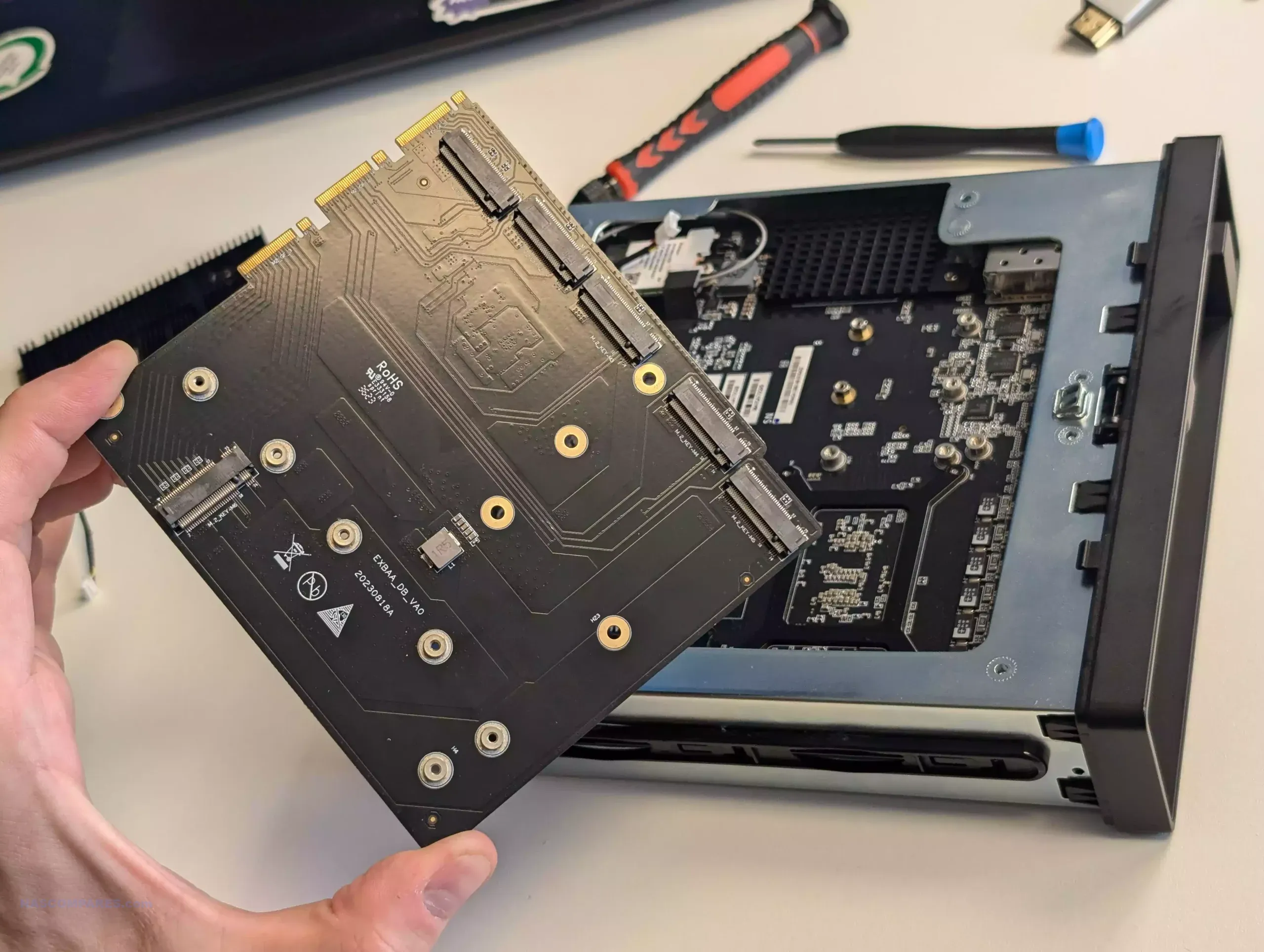
Prototype Overview
The upgrade card aims to expand the MS-01’s storage by converting the three existing M.2 slots into six M.2 NVMe slots, each measuring 2280 in length.
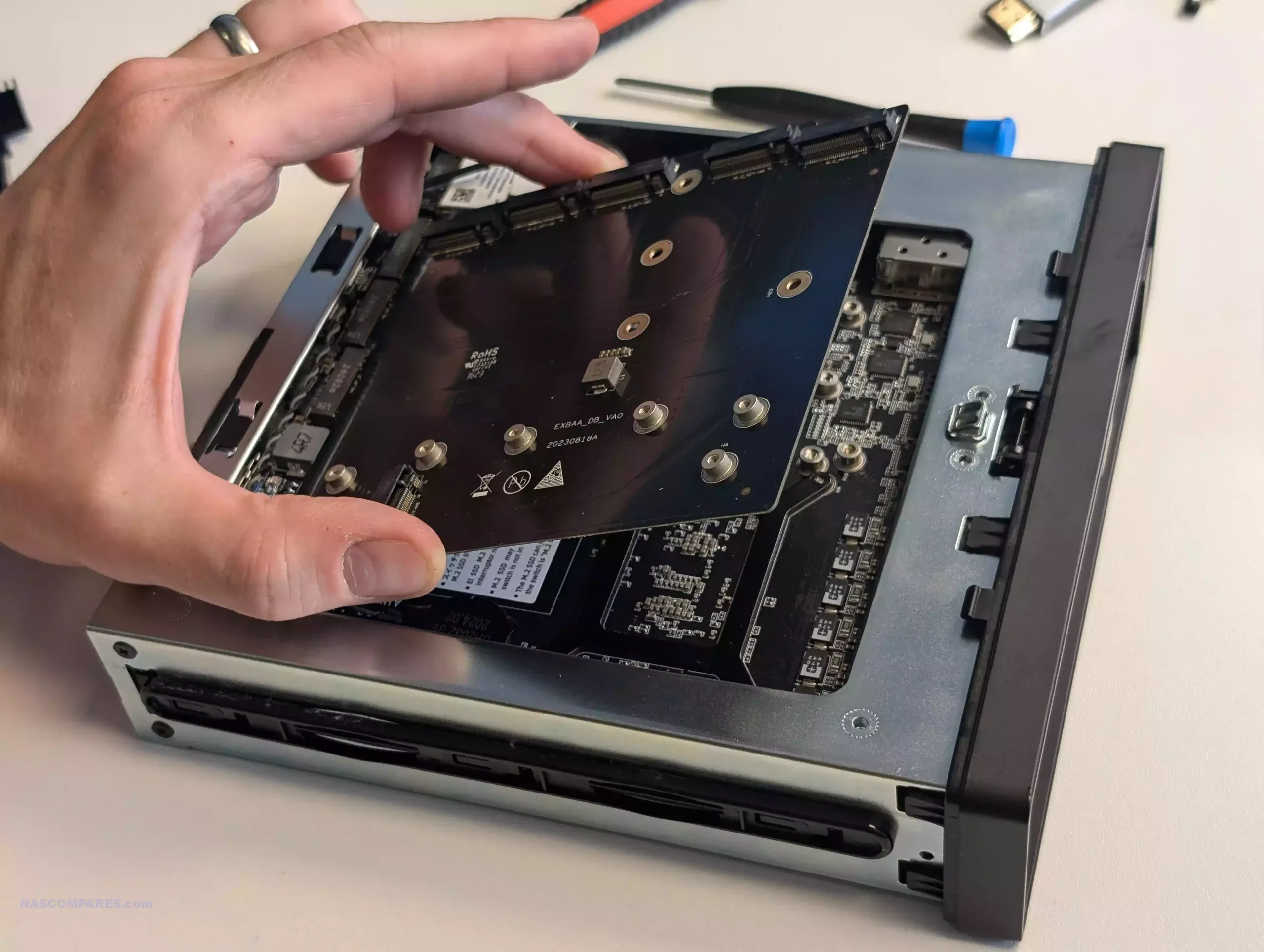
This conversion directly addresses initial criticisms about the limited and varied lane configurations of the original M.2 slots, which hindered optimal performance, particularly for users looking to fully utilize the 10G ports.
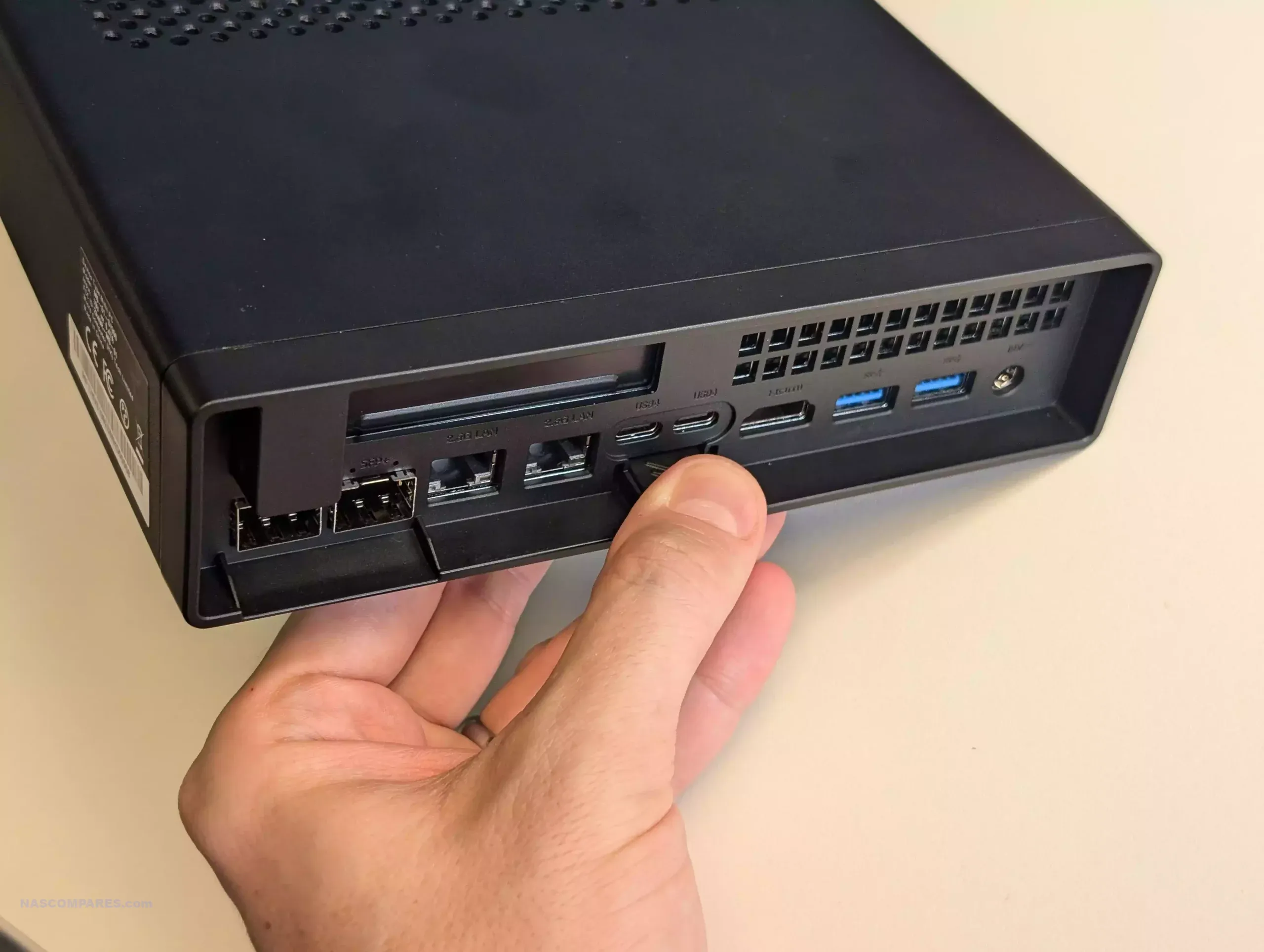
Currently, the upgrade card is in the prototype stage, with no guarantee of it reaching the retail market. The prototype lacks integrated cooling solutions, a critical issue given the substantial heat generated by six M.2 NVMe slots and the Intel i9 CPU. Moreover, a custom BIOS update is required for the card to function correctly, involving extensive communication with MSI Forum to ensure proper configuration.
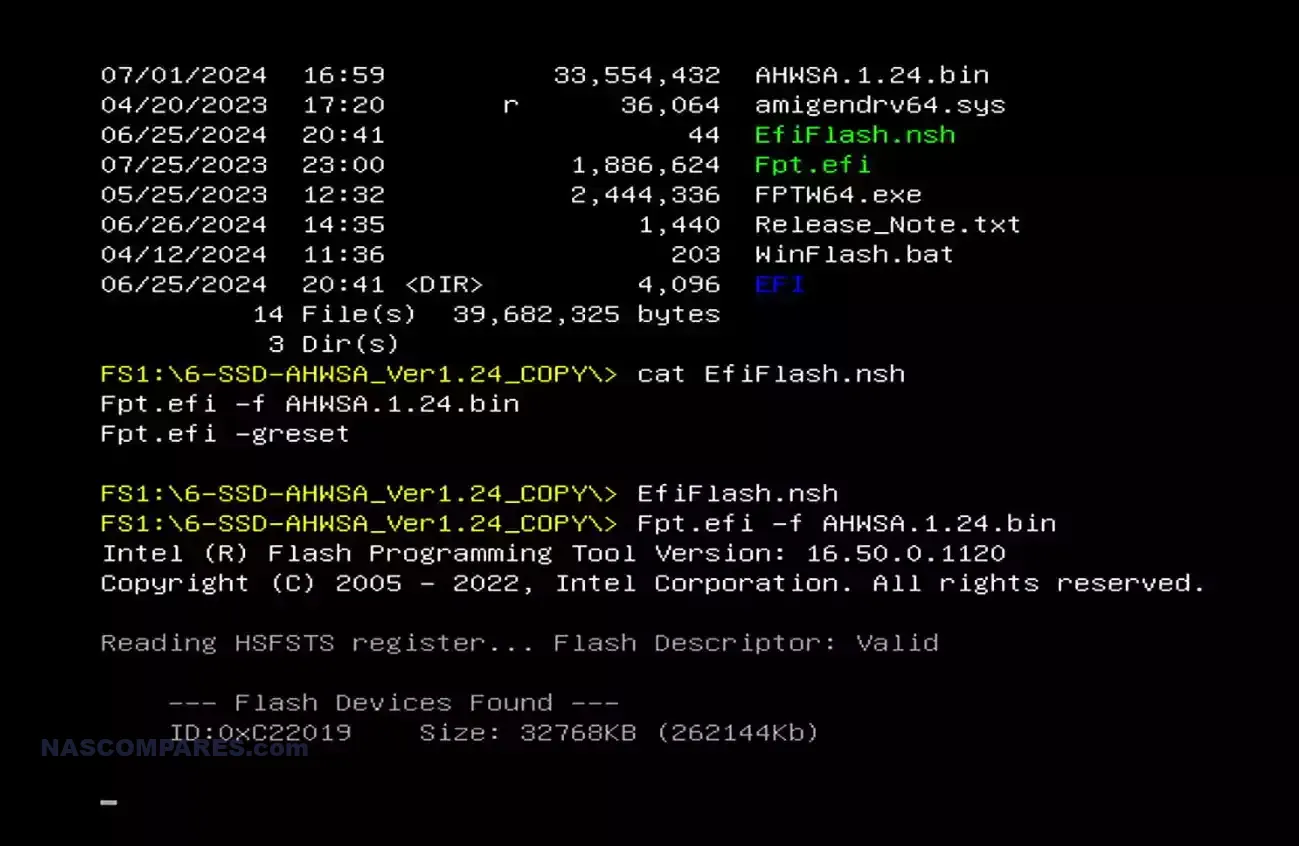
Design and Installation Challenges
The design of the upgrade card is clean and straightforward but introduces significant cooling challenges. The original cooling system of the MS-01 cannot fit in the casing with the upgrade card installed, and there is limited space for heat sinks for each SSD. This necessitates alternative cooling solutions to maintain optimal performance and prevent overheating.
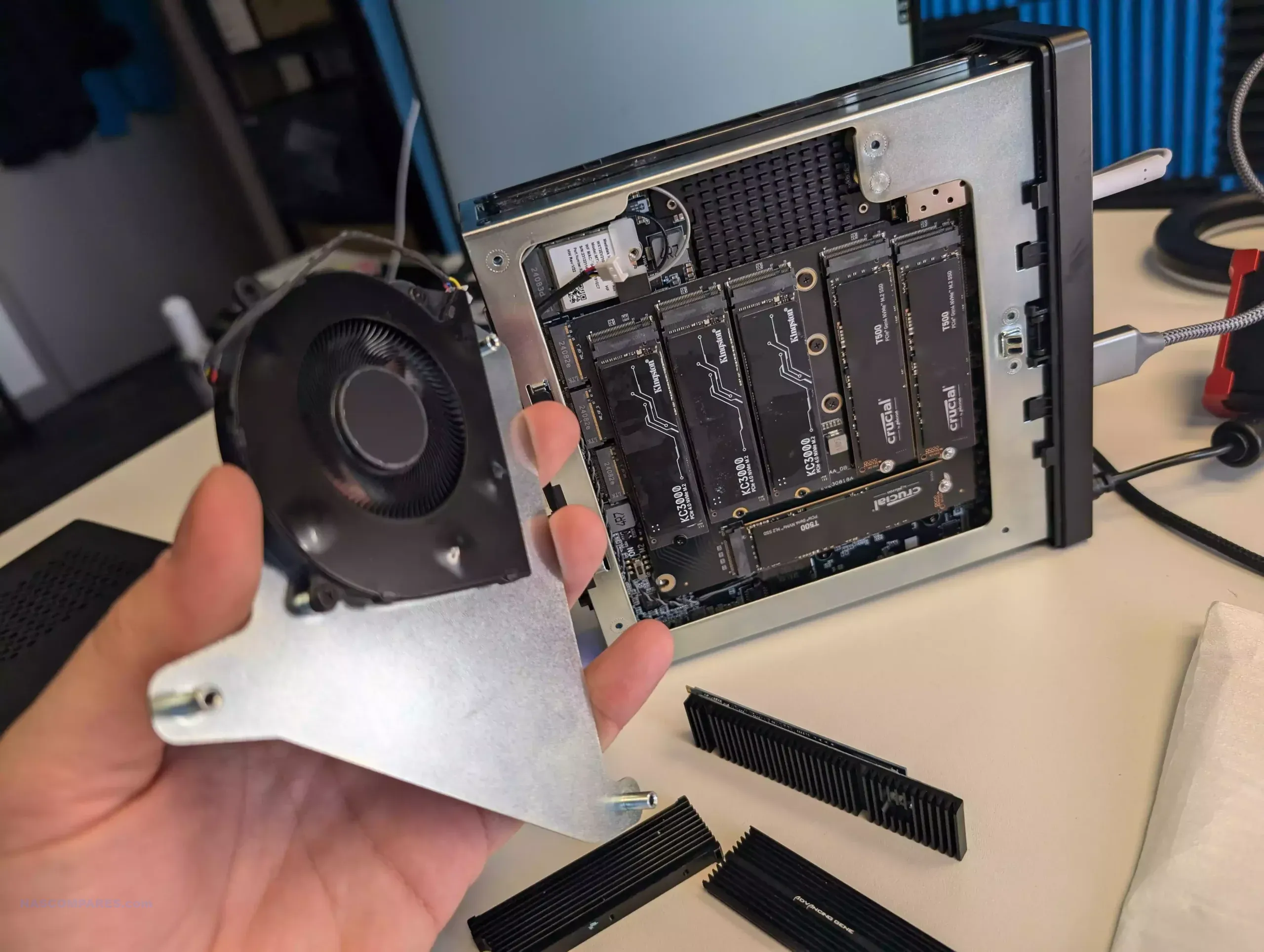
The installation process involves sliding the prototype card into all three M.2 slots on the original MS-01 and securing it with screws. This process ensures the card is firmly in place and properly connected to the MS-01’s internal architecture. However, the simplicity of the installation belies the complexity of managing heat and ensuring adequate power distribution to the new slots.
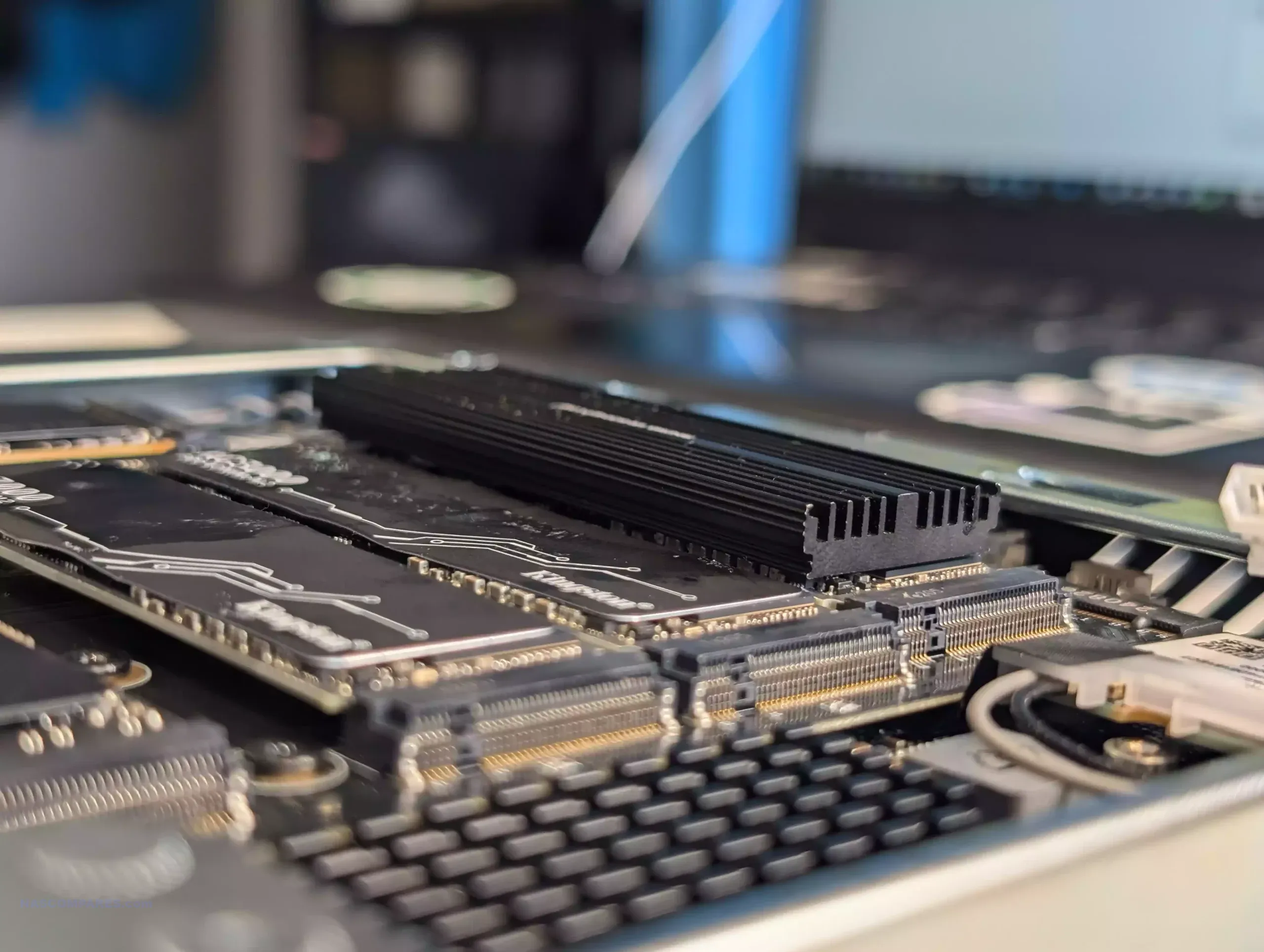
Lane and Power Distribution
The lane distribution of the upgrade card is crucial for its performance. The upgrade card redistributes the lanes as follows:
- One 3×2 slot
- Four 3×1 slots (sharing a single 3×4 lane)
- One 4×4 slot
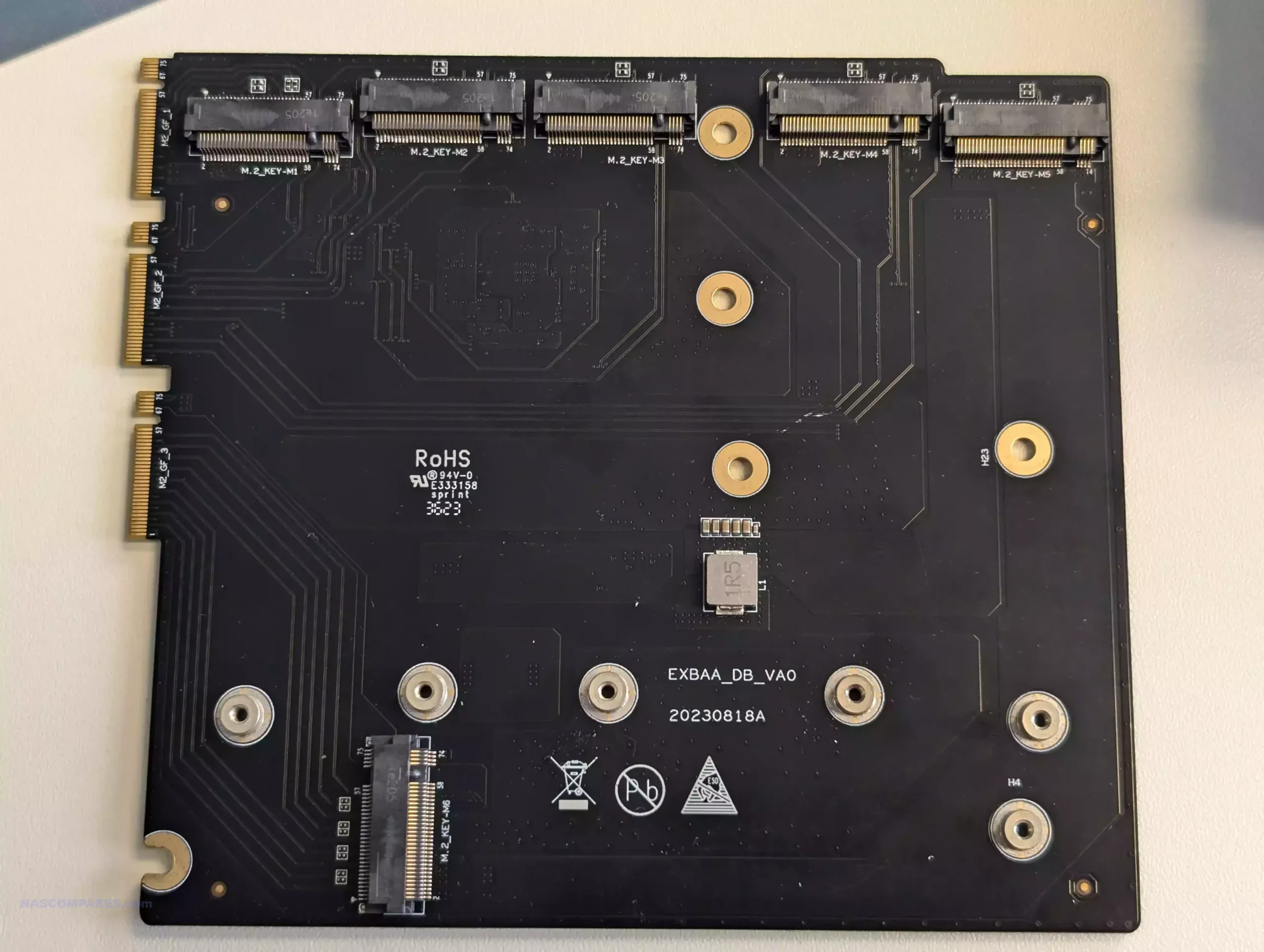
This configuration results in varied bandwidth capabilities across the slots.
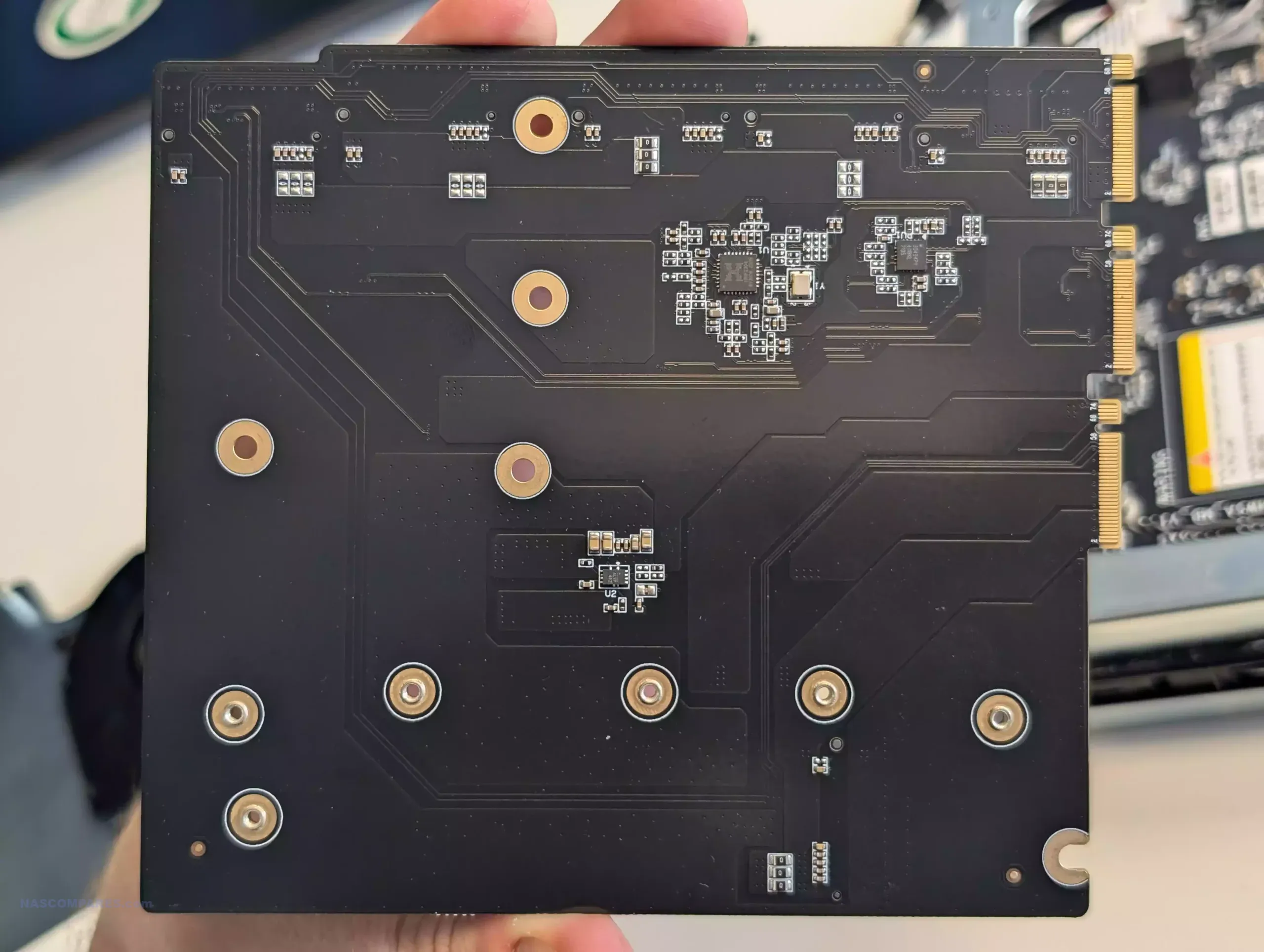
The four middle slots (M.2 slots 2, 3, 4, and 5) share the bandwidth of a single 3×4 lane, effectively making them 3×1 each. This setup can impact the performance of these slots, particularly when all are in use simultaneously.
| M.2 Slot | Lane Distribution |
|---|---|
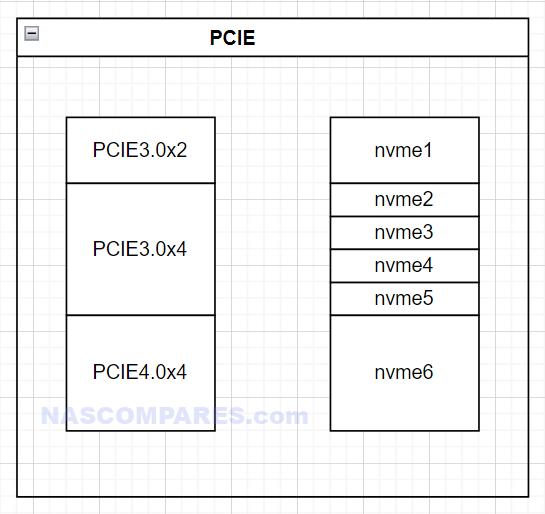 |
|
| Slot 1 | 3×2 |
| Slot 2 | 3×1 (shared 3×4) |
| Slot 3 | 3×1 (shared 3×4) |
| Slot 4 | 3×1 (shared 3×4) |
| Slot 5 | 3×1 (shared 3×4) |
| Slot 6 | 4×4 |
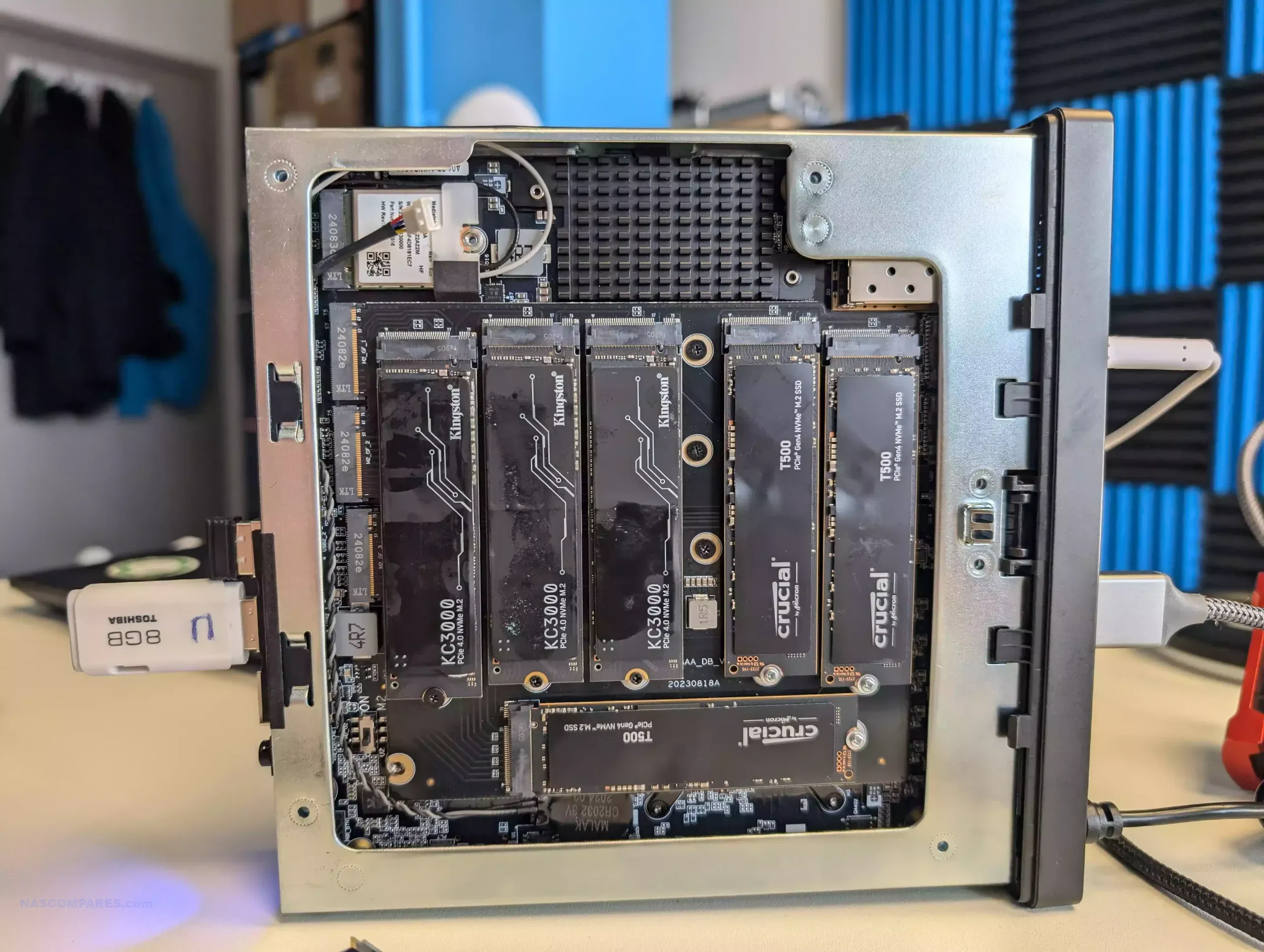
Power distribution is another critical aspect. The power distribution involves converting 12V to 3.3V where necessary, ensuring each NVMe slot receives the appropriate voltage. The provided diagrams detail the internal power management and distribution system, highlighting how power is routed from the MS-01’s M.2 slots to the upgrade card.
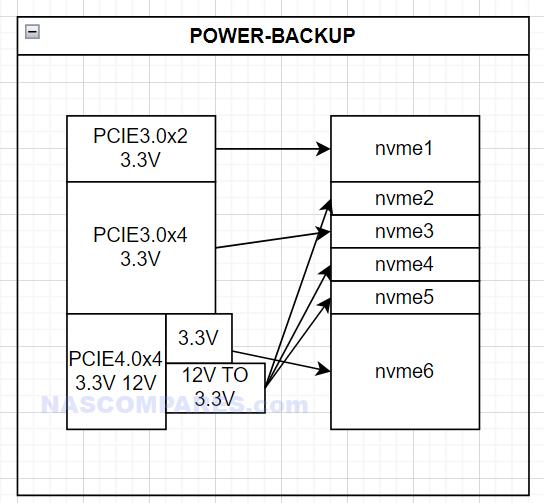
Buffer and Clock Management
Buffer management is essential for maintaining data flow between the M.2 slots and the connected card. A centralized buffer ensures that each NVMe slot receives the necessary data without bottlenecks.
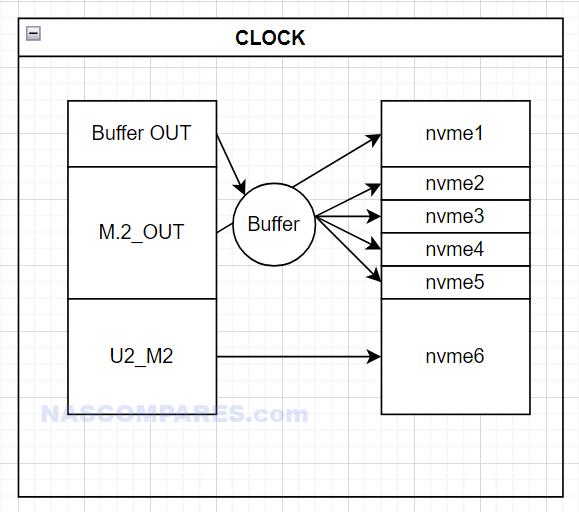
The diagrams illustrate these management systems, showing how data is routed and buffered effectively. Clock management is equally important, ensuring synchronization across all NVMe slots. Proper clock management maintains data integrity and consistent performance across the storage system.
Performance Testing
Performance testing was conducted using Unraid, focusing on both write and read speeds. The varied lane configurations resulted in different performance capabilities for each slot. The testing yielded the following results:
- Write Speeds:
- 3×2 slot: ~780 MB/s
- 3×1 slots (shared 3×4): ~1.4 GB/s collectively, ~350 MB/s each
- 4×4 slot: ~4.4 GB/s
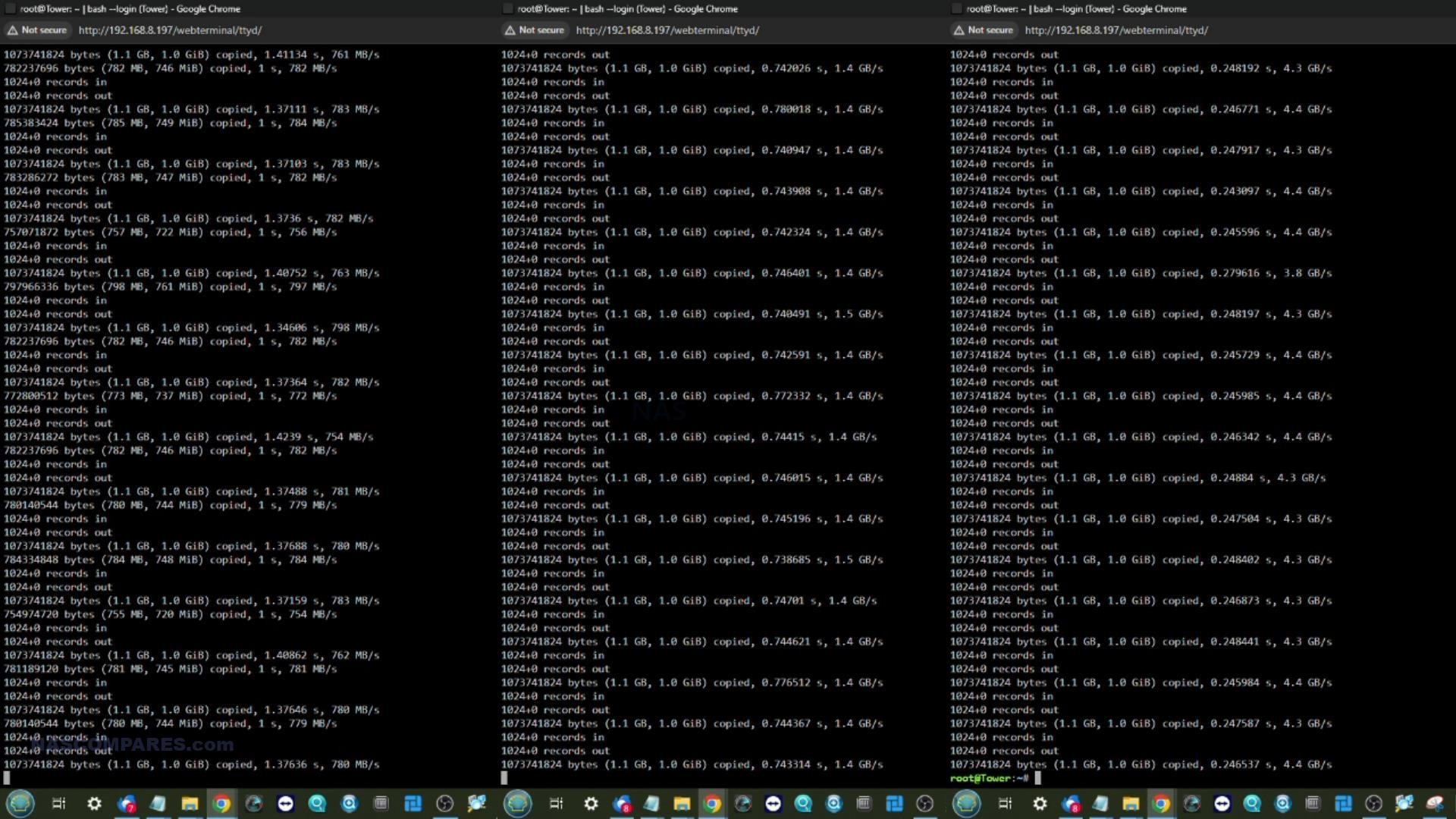
- Read Speeds:
- 3×2 slot: ~810-820 MB/s
- 3×1 slots (shared 3×4): ~1.6 GB/s collectively, ~400 MB/s each
- 4×4 slot: ~5.8-5.9 GB/s
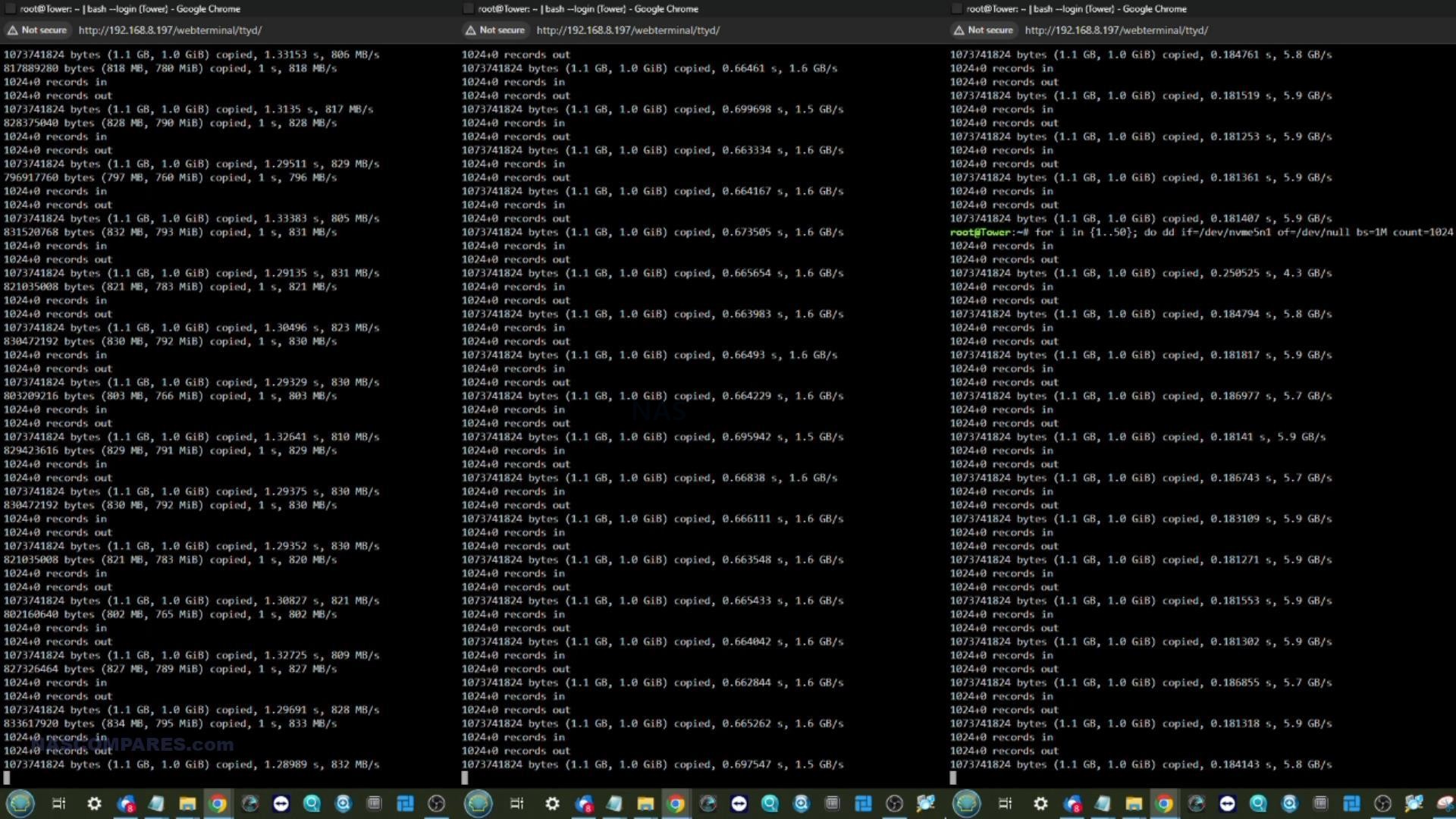
| Lane Configuration | Write Speed | Read Speed |
|---|---|---|
| 3×2 | ~780 MB/s | ~810-820 MB/s |
| 3×1 (shared 3×4) | ~350 MB/s each | ~400 MB/s each |
| 4×4 | ~4.4 GB/s | ~5.8-5.9 GB/s |
The test results indicate that the upgrade card can significantly enhance the storage capabilities of the MS-01. However, the shared bandwidth of the 3×1 slots (slots 2, 3, 4, and 5) suggests that performance might be limited when all these slots are in use simultaneously.
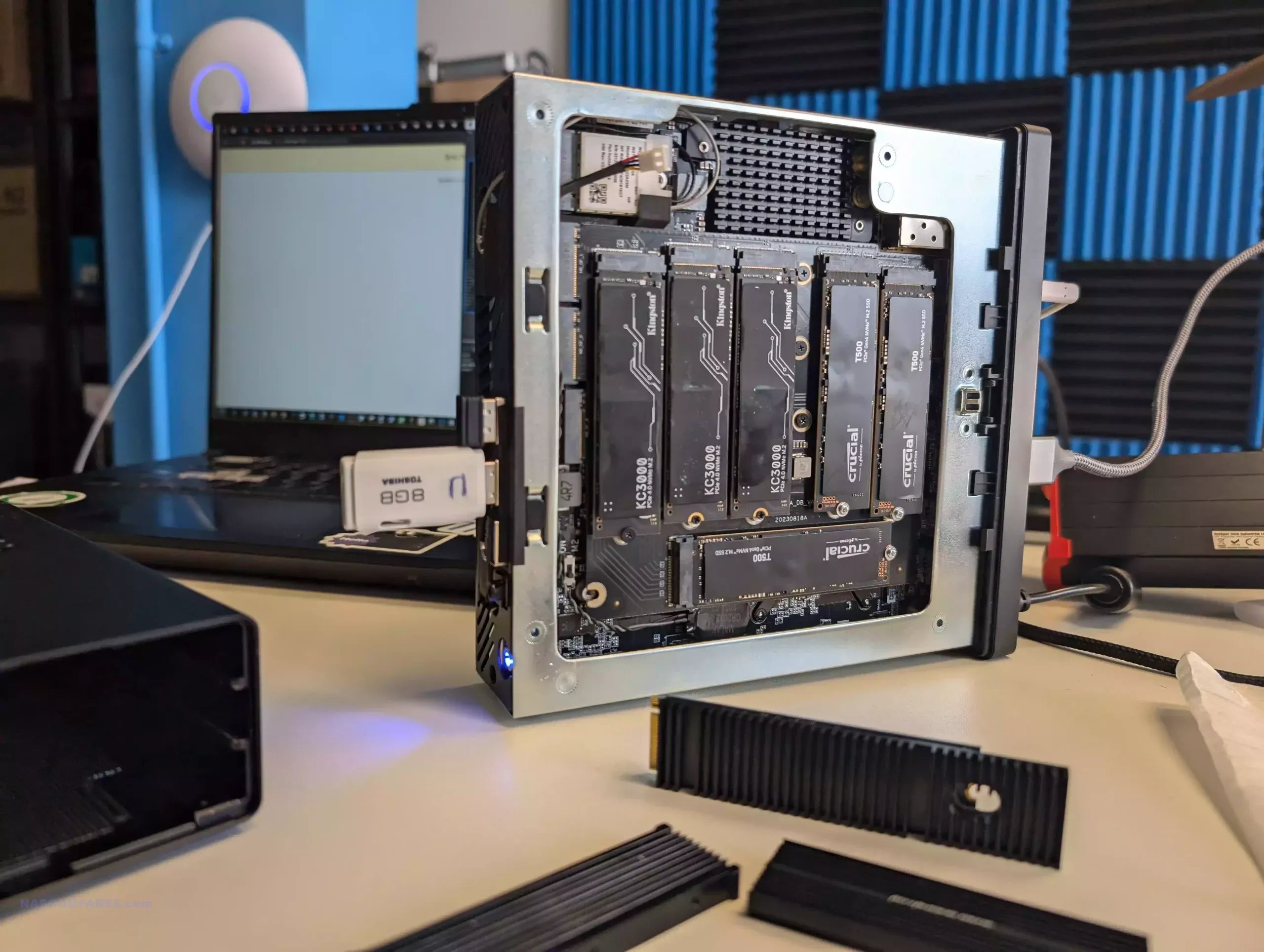
External Performance Challenges
External performance, especially with 10G connections, faced notable challenges. Single SFP 10G connections achieved full saturation, but dual 10G connections, whether using SFP or Thunderbolt to 10G adapters, encountered issues.
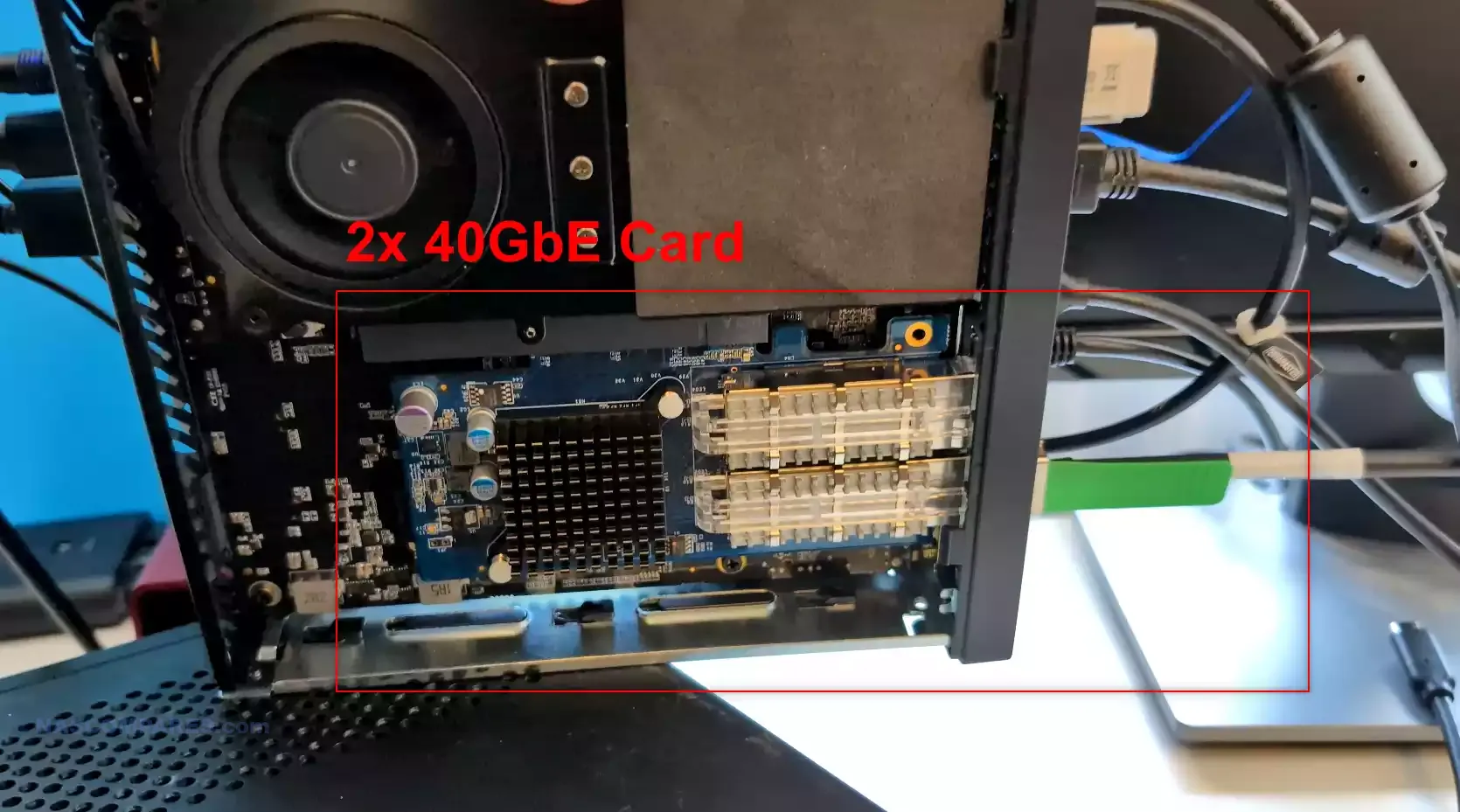
Testing with a 40G Ethernet card led to hardware crashes, which were attributed to the 40G card used in the test setup rather than the MS-01 or the upgrade card itself. An update on this test is expected soon, with plans to reattempt using a different test machine.
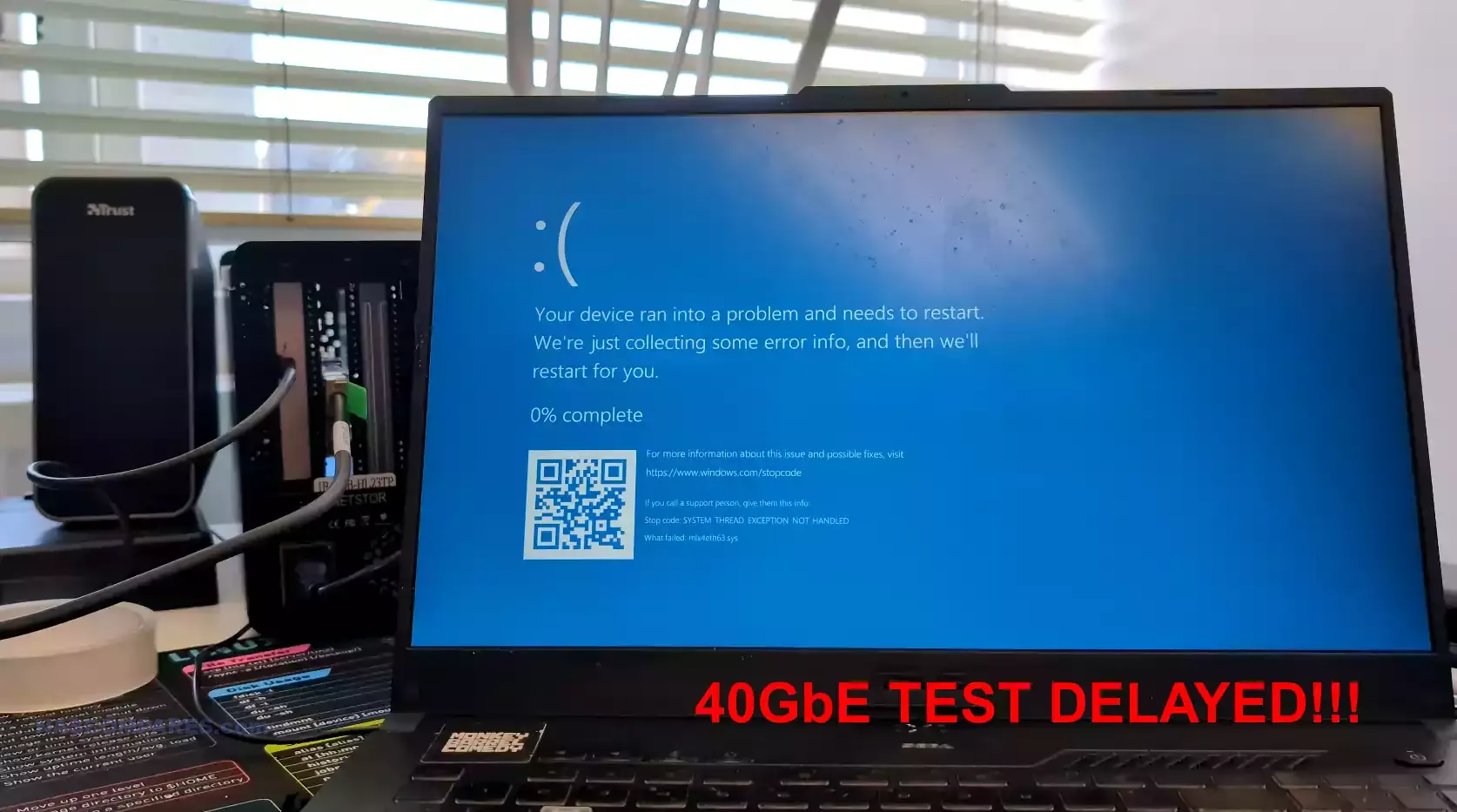
Future Prospects
The development of the prototype upgrade card showcases MSI Forum’s commitment to addressing user feedback and exploring innovative solutions. Despite the challenges, such as cooling issues and the need for custom BIOS updates, the project demonstrates a clear effort to enhance the MS-01’s functionality significantly.
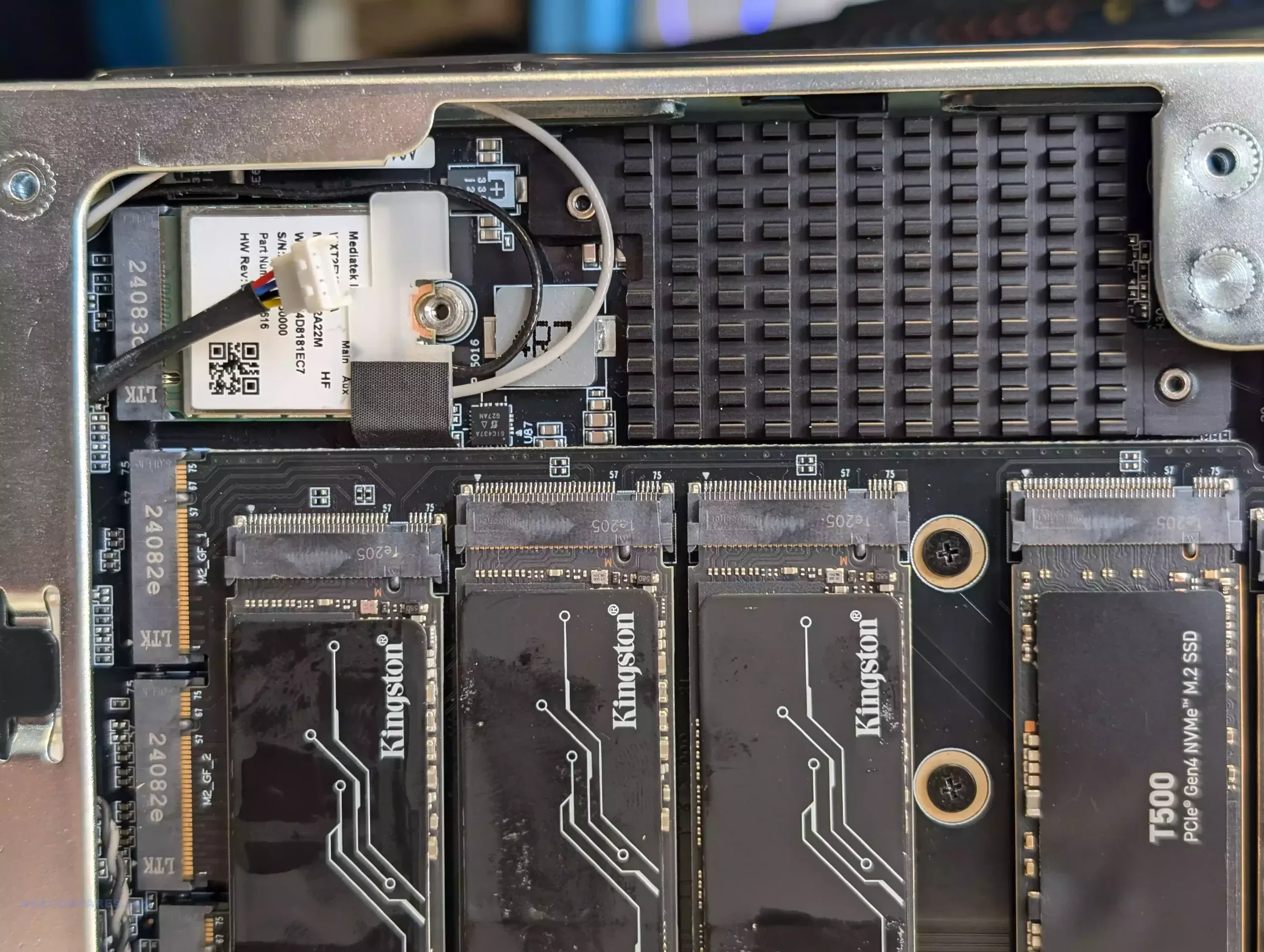
Conclusion
The prototype 6x M.2 storage upgrade card for the Minisforum MS-01 represents a promising step towards meeting the storage needs of high-performance users. While still in the prototype phase, the card has shown potential in significantly expanding the MS-01’s storage capabilities. The installation process, while straightforward, poses challenges in cooling and power distribution, which need to be addressed before the card can be considered for retail. Performance testing has shown promising results, particularly in write and read speeds, though the shared lanes in the middle slots may limit performance under full load. External performance testing highlighted issues with higher bandwidth connections, specifically with the 40G Ethernet card, but these are expected to be resolved in future testing phases. This article is a work-in-progress review of the MS-01 6x M.2 Card prototype and will be updated soon with more detailed findings and future developments. Stay tuned for the next installment as we continue to explore the capabilities and potential of this innovative upgrade.
|
Where to Buy the Minisfoum MS-01? |
🔒 Join Inner Circle
Get an alert every time something gets added to this specific article!
This description contains links to Amazon. These links will take you to some of the products mentioned in today's content. As an Amazon Associate, I earn from qualifying purchases. Visit the NASCompares Deal Finder to find the best place to buy this device in your region, based on Service, Support and Reputation - Just Search for your NAS Drive in the Box Below
Need Advice on Data Storage from an Expert?
Finally, for free advice about your setup, just leave a message in the comments below here at NASCompares.com and we will get back to you. Need Help?
Where possible (and where appropriate) please provide as much information about your requirements, as then I can arrange the best answer and solution to your needs. Do not worry about your e-mail address being required, it will NOT be used in a mailing list and will NOT be used in any way other than to respond to your enquiry.
Need Help?
Where possible (and where appropriate) please provide as much information about your requirements, as then I can arrange the best answer and solution to your needs. Do not worry about your e-mail address being required, it will NOT be used in a mailing list and will NOT be used in any way other than to respond to your enquiry.

|
 |
The BEST NAS of 2026.... ALREADY??? (UnifyDrive UP6)
How Much RAM Do You Need in Your NAS?
A Buyer's Guide to Travel Routers - GET IT RIGHT, FIRST TIME
Jonsbo N6 DIY NAS Case Review
The Best Bits (and Worst Bits) of NAS of 2025!
Minisforum MS-02 Ultra Review
Access content via Patreon or KO-FI
Discover more from NAS Compares
Subscribe to get the latest posts sent to your email.


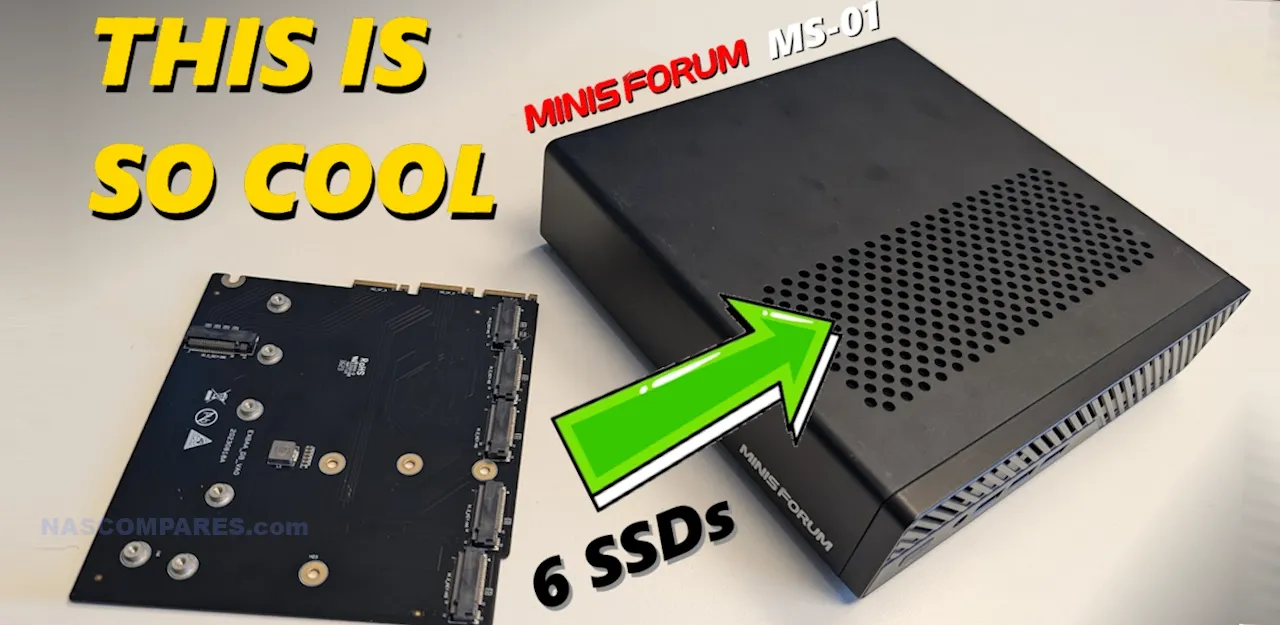



Does the PCIe slot support biterfication? I want to buy a dual slot card for more NVMe drives but it maybe pointless.
REPLY ON YOUTUBE
Which SFP+ to rj45 do you use ?
REPLY ON YOUTUBE
… most nas review are just sposored videos from the vendors. CRAZY prices. this is not what a NAS should be
REPLY ON YOUTUBE
What pcie nvme cards would fit in there? Total.max nvme drives
REPLY ON YOUTUBE
Little OverKill for NAS 😀
REPLY ON YOUTUBE
The famed *Barbone* setup.
????
REPLY ON YOUTUBE
Will Gen4 SSDs with heatsink actually fit? I was thinking something like the 4TB Kingston FURY Renegade with heat sink (10.5 mm)
REPLY ON YOUTUBE
can any one confirm if any expansion cars fits in the pcie slot
e.g TEKQ Databank M4 Support 4 Port M.2 SSD Expension Card PCIe 3.0 x 16 PCIe Adapter Card, Up to 32TB RAID Controller Card Broadcom PEX-8724, Supports Non-Bifurcation Motherboard, with Active
will this fit in the pcie slot
thank you
REPLY ON YOUTUBE
What is the purpose of storage adapters if you can achieve the following configurations?
– Samsung SSD PM9A3 OEM Enterprise 2.5″ 7mm U.2 PCIe NVMe 15.36 TB (compatible with PCIe 4.0 x4 slot)
– Samsung PM9A3 OEM Enterprise/DataCenter M.2 22110 NVMe 3840 GB (compatible with PCIe 3.0 x4 slot)
– Samsung PM9A3 OEM Enterprise/DataCenter M.2 22110 NVMe 3840 GB (compatible with PCIe 3.0 x2 slot)
REPLY ON YOUTUBE
Home use as NAS should be okay, but not good for business use as NAS as this mini PC does not support ECC memory! I’m still waiting for a mini PC that has ECC support.
REPLY ON YOUTUBE
Intel’s Oxidation flaw will prepare this setup for a fall.
REPLY ON YOUTUBE
who already returned their ms-01? Forums are full of this thing crashing randomly. Don’t buy this if you’re going to use it as a NAS
REPLY ON YOUTUBE
Absolute crap quality. Died just 2 months after using it. I already had problems on Installation. Never again Minis-Forum.
REPLY ON YOUTUBE
Like others pointed out, unless its for very high bandwith demanding intermediate storage for specific professional cases, I fail to see a point in nvme SSD raids due to the wear and tear on those high speed SSD’s. At least not for the home or consumer usage front.They’ll be dead in a couple years where a typical spinner raid can run 24/7 with a little luck for 5+ years without needing to exchange a drive. It’s still a nice little server box for a multitude of usage with those 2 10gig network cennections build in. Kinda perfect with an 8×2,5gb + 2 10gb switch to upgrade the home network. Just point me to an external box that can hold 8×3,5″ HDD’s with the MS-01
REPLY ON YOUTUBE
The thing that lets this down is the max RAM… I’d current run 3x Dell Optiplex with i9-10900 and 128GB RAM.. I’d have flogged then by now and ordered 3 of these, but from a RAM perspective, these would be a downgrade.
REPLY ON YOUTUBE
Too bad cheap thunderbolt drive racks don’t exist
REPLY ON YOUTUBE
could you please do a bios dump of the Minisforum MS-01 it seems like everyone in the text space is absolutely infatuated with Minisforum and they keep ignoring the fact that several Mini PC manufacturers out of China have shipped systems with malware now granted Minisforum has it done that as far as We Know but I think it would help Grant peace of mind to security minded people who want a Mini PC
REPLY ON YOUTUBE
They are coming out with the AMD version of this according to CES. Withouth 10GB networking. Waiting to see what that ends up being. I have the barebones 13th gen i9 I have 64GB ram in it and 2tb NVMR. Running Unraid using Iscsi to connect to my QNAP works great. Jim’s Garage has a great video on using three as a cluster for Proxmox with ceph.
REPLY ON YOUTUBE
Is there anything with onboard integrated transcoding and 2x m2 with 2x 2.5 sata?
REPLY ON YOUTUBE
But what year is it?
REPLY ON YOUTUBE
I think it’s only a matter of time until they release a new MOBO for NAS.
REPLY ON YOUTUBE
Looking at it right now. Do i get the i5 12600h or the i9 13900h? Sadly the middle on is not available in barebones.
REPLY ON YOUTUBE
Hi, i would like to dip my toes into the homelab/server stuff. Do you recommend aoostar r7 for this purpose?
REPLY ON YOUTUBE
1306 Australian dollars.. farg off!!
REPLY ON YOUTUBE
I’ve ordered the i5 version of this as it uses a little less power, and half size QNAP SFF 8088 PCIe HBA + 4 bay SAS JBOD. I plan to pass the disks directly through to OMV in Proxmox. I can link the unit to my existing Proxmox server via USB4 and it’ll be the start of a nice little cluster. Crazy performance for the money (assuming everything works!)
REPLY ON YOUTUBE
I bought mine last month for a NAS
REPLY ON YOUTUBE
At ~$400 you couldn’t build yourself for this cheap, not at that size with those specs anyway. A few of these in a Proxmox cluster would be fantastic. As a NAS you have choices with the thunderbolt for more storage. I hope they build off this idea in the future with just a little more space for the pcie slot and perhaps an amd version.
REPLY ON YOUTUBE
I hope it can cool a HBA low profile card.
REPLY ON YOUTUBE
I do not care about speed. I just want a 12 or 16 bay NAS that can take NVMe drives that are as fast as standard drives…
REPLY ON YOUTUBE
This is exactly what I was looking for, a M.2 NAS desk companion with thunderbolt 4 capability for quick media transfer. Using the the fastest NVMe port and a PCIe to 2x NVMe I can have a 6TB pool at Gen4 speeds. No raid needed in my use case since I’ll be replicating data to my central cheaper spinning disk NAS (Zimacube Pro that will hopefully arrive in 2024)
REPLY ON YOUTUBE
imo, this is *the* perfect homelab Proxmox cluster box — get 4 of the i5 version ($399(!!!!!!) apiece!), load them up with NVMes and you have yourself a terrifyingly cost-effective all-Flash Ceph cluster that can run any VM or container load you can name.
REPLY ON YOUTUBE
I have a QNAP TL-D1600S connected to Minisforum MS-01. It makes an awesome home media server ????with 16 bays!
This JBOD is fast enough for my use case (RAIDZ with 2 VDEVs), but if it is within your budget, the 1-device solution QNAP TVS-h1688X has ECC memory and may give better performance.
REPLY ON YOUTUBE
Another option for Thunderbolt is the OWC Thunderbay 8. That provides 8 bays on a quiet chassis, using the MS-01 has a processing head unit that’s easily changed over. Not SAS signaling, but quiet and maintain SMART for individual drives…
REPLY ON YOUTUBE
So i did something really hacky, but still kind of amazing. I used a m.2 A+E converter and a 2TB 2230 drive. I also used a QNAP QDA-U2MP to put 2 more m.2 drives in the gen 4 slot. So i was able to get 5 2TB drives in there, but i’m not certain about the heat yet. And the pcie slot is still free.
An array of those 5 drives can push 3800 MB/s read speeds in Crystaldiskmark. Its the 2230 drive that slows it all down, but It still saturates a 10G link.
REPLY ON YOUTUBE
No wifi 6??
REPLY ON YOUTUBE
Have to object made in China products as security issue in your local country
REPLY ON YOUTUBE
I don’t see the appeal for this as NAS. I guess if you need it for content creation.. but NVME all NASs would give me enough storage. So at that point run a single system with 2 pools. For a basic 2-4TB NVME nas its wayyy overkill
REPLY ON YOUTUBE
Hey mate, could you send me one of those gratis with a 8TB M.2 NVME boot drive and a Solidigm D5-P5430 30.72TB in the U.2 to NVME adapter and another D5-P5430 30.72TB in a 2.5-inch U.2 SSD to PCIe Adapter?
When the 61.44TB D5-P5336 is available could you send me a pair of them to replace the 30TB drives?
I’d like to use this as my Plex sever and be able to load ALL my videos on it.
Thanks a million and stop laughing so hard, you might hurt yourself! ????
REPLY ON YOUTUBE
Wait a minute…
The Asustor Dual M.2 + 1x 10GbE Card – AS-T10G3 – WORKS in a non- Asustor Nas?
I was under the impression that it only functioned in a (from the Asustor website) “in a compatible ASUSTOR NAS with a PCIe 3.0 x4 interface.”
If it works on any motherboard with a PCIe 3.0 x4 interface I’ll order one today.
REPLY ON YOUTUBE
what do you mean you cant use raid?…..how is this a decent nas then?…….or did you mean you shouldnt use raid due to the diff m.2 speeds?
REPLY ON YOUTUBE
Do you know when getting the MS-01 with the ram/ssd included is it 1 32gb dimm or 2x 16gb dimms?
REPLY ON YOUTUBE
Cannot wait to see it with the PCIe board and 2 additional NVMEs. Cheers from Brazil!
REPLY ON YOUTUBE
Wendel was just looking at this thing and putting a DAS card in there, then attaching to something and it could something that could really change stuff
REPLY ON YOUTUBE
Wondering how it would work with something like Asus m2 cards 4x m2 as an addition to already existing m2 ports.
REPLY ON YOUTUBE
I have seen MINISFORUM machines for quite some time and used several of them in my (cough, undisclosed) applications. They are indeed truly impressive. What I do like about them is that they are power-houses where needed. They tick a lot of boxes for me, and the prices are fair.
Using it as a NAS is not really what I have thought off before but worth considering.
Thank you for pointing that out!
REPLY ON YOUTUBE
I hope they release an AMD version with ECC support…
REPLY ON YOUTUBE
If you wanted to use the MS-01 as a NAS, IMO the best way to go about it would be to install a LSI SAS card, install a couple NVMe drives, install Proxmox with the NVMe drives in a RAIDZ1 just for redundancy, create a TrueNAS Scale VM, and use PCIe passthrough to pass the LSI SAS card and one (or both) of the 10 Gbps SFP+ ports to the TrueNAS Scale VM. Then, connect the SAS card to a SAS disk shelf and setup your ZFS pool(s) in TrueNAS Scale.
This way you still have the space and headroom to create a bunch of VMs in Proxmox and such, as frankly, the power of the MS-01 is kind of wasted if all you’re doing with it is a NAS, and I don’t think TrueNAS is necessarily the best platform for hosting VMs and Docker containers.
On my MS-01, I’ve got Proxmox on it, but I am trying to sort out Intel AMT remote management with MeshCentral. MeshCommander remote KVM works fine but MeshCentral remote KVM is tricky to get working for me.
REPLY ON YOUTUBE
Actually there are 4 nvme ports on it 🙂 the wifi port can be used for 2230 A+E vnme or with a 15£ extension cable (that converts A+E to B key) that allows you to put your 2280 somewhere else, you get access to 2x pcie 2 speed at which boot drives are just perfect there (and yes, this is tested, supports secure boot etc – this is how my nodes boot and work without a problem)
Bottom line is that this is perfect for ceph NVME storage + a lot of horse power for vm / containers.
Answering further questions: yes hybrid CPU works just fine with proxmox 8, there are no real problems with it, yes the iris graphics inside of the CPU works without a problem, no there is no hardware watchdog, no there is no TPM, x710 ports work perfect with LACP so do 2.5gb ports, connect those directly to SFP switch to lower the heat and power consumption, the PCIE slot is only pcie4 x8 but it many LSI HBA cards fit into that, do not underestimate the USB-C DAS docks – those do work pretty fast with this puppy and so far had pose no issues for us (and consume far less power than HBA + external psu for sata (also less messy), CPU is rather ludicrous fast and for 30 empty VM’s inside of proxmox in a cluster we experienced average 0,4% cpu usage (the AES accelerators etc help a lot!).
BUT
bare in mind that this is a miniPC not a enterprise grade server, so if you get kernel crash of memory corruption – don’t come out crying that this is S*** because it works for other people – rather than investing an arm and leg into enterprise server that will cost a pretty penny and suck electricity out of socket like mad, get few of those and create distributed filesystem where corruption on one node will be found later on and fixed with clean copy from non corrupt node.
BTW, a note about the 2 lanes of pcie3 for third NVME slot – let’s face it, it’s more than double 10GBe can handle, so there is no real problem here. You simply can’t push data fast enough into this system for this to be a bottle neck. Yes your array rebuild speed will suffer ,HOWEVER, most nvme WILL throttle after few gigabytes of writes as those will saturate the ssd buffer and speeds will drop well below pcie3x2 speeds – negating any pcie speeds.
BTW 2, using pcie slot for extending storage with 2 NVME is a no go. The slot does not support bifurcation so system will see only a single nvme drive the extender card. There are cards that have internal PCIE switch that will do bifurcation, but those come mostly in 4 drive combo that will unfortunately NOT fit within the case.
REPLY ON YOUTUBE
I have one and it’s great! I’m using it for proxmox. I’m using a lower version of this as an Emby server which pulls videos from my Synology for playing.
REPLY ON YOUTUBE
AWESOME video man !!
REPLY ON YOUTUBE
Great video and timing. Was looking to build a SFF plex with UNRAID 7, this might just be the ticket!
REPLY ON YOUTUBE